![]()
![]()
![]()
Use LEFT and RIGHT arrow keys to navigate between flashcards;
Use UP and DOWN arrow keys to flip the card;
H to show hint;
A reads text to speech;
56 Cards in this Set
- Front
- Back

|
Name: Female Figure
Medium: White Marble Place: Cyclades Date: 2500 BCE Period: Aegean Sig: Resemble abstract forms of modern 20th century art, shield-like head, very flat when looked at from the side; Shapes consist most of triangles (both the head, the body as a whole, nose, shoulders, and pubic area); Most were found in funerary contexts (found laying on their backs inside graves; perhaps meant as a stand in for the body but remember it’s prehistory so we can’t know for certain) |
|
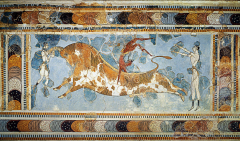
|
Name: Bull Leaping Fresco
Medium: Wall Painting Place: Knossos Date: 1550-1450 BCE Period: Aegean Sig: Bulls are frequently included in Minoan art and storytelling (ie Minotaur); There seems to be an acrobat flipping over the bull very gracefully while other two people are there doing something; the figures are pretty androgynous, we can’t really tell if they are male or female |
|
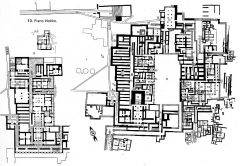
|
Name: Plan of the Palace Complex, Knossos
Medium: Plan Place: Crete Date: 2000-1375 BCE Period: Aegean Sig: The legend of the minotaur does not exaggerate the mazelike qualities of the Palace at Knossos; Had a square like plan with a courtyard in the first period; the mazelike qualities seem to come from repairs to earthquake damage during the Second Palace (there was a huge earthquake at one point and this had to be completely rebuilt at that point); Used rubble masonry; gave though to drainage of rain water (had plumbing through terracotta piping network; very advanced/unprecedented at the time); Likely had multiple stories, but we only have the ground layer left |
|
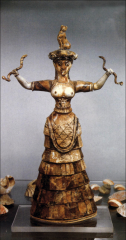
|
Name: Women or Goddess with Snakes
Medium: Place: Knossos Date: 1700-1550 BCE Period: Aegean Sig: No large monumental sculptures have been found (unlike Ancient Egypt); there may have been large wooden sculptures, but that would have deteriorated long ago; Same kind of clothing as the young girl in the work before; perhaps she is a priestess or goddess (has snakes in her hands and a leopard on her head, which may have been symbols of power) |
|
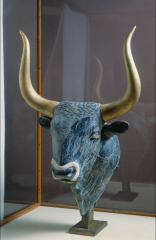
|
Name: Bull's Head Rhyton
Medium: Steatite with shell, rock crystal and red jasper, the gilt wood horns restored Place: Knossos Date: 1500-1450 BCE Period: Aegean Sig: A ryhton is a vessel used to pour liquids in ritual ceremonies (there is a hole in the back of the bull’s neck, and the liquid that is poured in there could be poured out of the bull’s mouth); The horns would have been wood covered in gold (they are reconstructed); Beautifully carved with a great deal of attention to detail to portray the bull naturalistically |
|
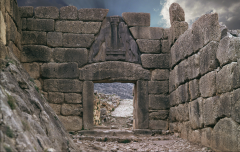
|
Name: Lion's Gate
Medium: Limestone relief Place: Mycenae Date: 1250 BCE Period: Aegean Sig: Attests to the warlike nature of the Mycenaean culture, Another example of a post and lintel construction with corbeled wall above it (to place less weight on the lintel), What does lie on the lintel is the carving above it, with two lion bodies facing an inverted column (the heads of the lions are no longer there, but would have been attached separately; we don’t know what the heads were made of or if they were even lion heads or human heads on top of the lion’s bodies) |
|

|
Name: Funerary Vase (Krater)
Medium: Terracotta Place: Dipylon Cemetary, Athens Date: 750-700 BCE Period: Geometric Greek Sig: Far too large to be practically used for bathing and the bottom is taken out; additionally it was found in a cemetery; This indicates that it was used to mark graves (kraters were used for dead men), This period of art is so called because of the emphasis on geometric shapes in art (In this work, there is a great deal of checkerboard and zig zag designs), There is a dead guy on a funeral pyre (underneath a shroud) surrounded by mourning women who are literally tearing their hair out |
|

|
Name: Temple of Hera I
Medium: ???? Place: Paestum, Italy Date: 500 BCE Period: Archaic Greek Sig: Trade with Egypt brought Greece into contact with monumental stone architecture; shortly thereafter, such architecture reappears in Greece, To the Greek mind, proportion in art and architecture reflected some sort of cosmic order: early examples of temples have a 1 to 3 ratio between the lengths of the side, • Greek columns seem to grow larger and swell towards the bottom (Makes it look like a strong, solid work of architecture as it seems to be struggling under the weight of all the stone above) |
|

|
Name: Dying Warrior
Medium: Marble Place: Temple of Aphaia, Aegina Date: 500-490 BCE Period: Archaic Greek Sig: Turned on his size so that he can fit in the corner of a triangular sculpture, Has the archaic smile (like all the kouri), seems very unfazed by the arrow that has pierce his chest |
|

|
Name: Kouros
Medium: Marble with remnants of paint Place: Anavysos Date: 530 BCE Period: Archaic Greek Sig: Emulate the stance of Egyptian statues (see Menkaure and his Queen): standing with one foot forward with fists clenched (except these arefree from the block), Begin to replace kraters as grave markers, Later on, there is an increased emphasis on how realistic the sculptures are relative to earlier Kouri |
|

|
Name: Peplos Kore
Medium: Marble Place: Acropolis, Athens Date: 530 BCE Period: Archaic Greek Sig: Female version of the Kouri, were found largely in temple complexes (as opposed to the funerary significance of the male Kouri) perhaps indicating use as a votive statue (used as stand ins for worshippers), Wears a peplos (cloth dress that is belted at the waist) |
|
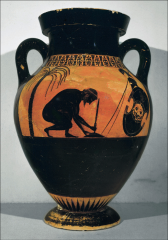
|
Name: The Suicide of Ajax
Artist: Exekias Medium: Black-figure decoration on an amphora Place: Date: 540 BCE Period: Archaic Greek Sig: Many of the works from the archaic period were signed by both the potter and the artist; many of these are very popular as trade items (many that remain were found in Etruscan tombs), Didn’t divide the pot into horizontal bands but rather has one large panel with monumental figures |
|
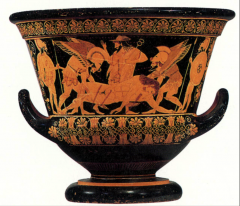
|
Name: Death or Sarpedon
Artist: Euphronias (painter) and Euxitheos (potter) Medium: Red-figure decoration on a calyx krater, ceramic Place: Date: 515 BCE Period: Archaic Greek Sig: Attention to perfection and detail in the human form is noticeable in the abdomen of Sarpedon |
|

|
Name: Dying Warrior
Medium: Marble Place: Temple of Aphaia, Aegina Date: 480 BCE Period: Classical Greek Sig: Only a decade or two later than the dying warrior from the west pediment and is much more representative of the classical style (Doesn’t have the archaic smile; he still has a very stylized face, but he actual looks like he’s dying, you can see the anguish on his face, He contorts and twists his whole body as he pulls out an arrow; increased emphasis on naturalism and humanness) |
|
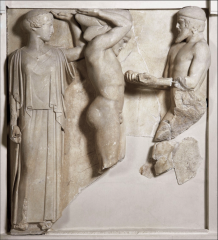
|
Name: Athena, Herakles and Atlas
Medium: Marble relief Place: Temple of Zeus, Olympia Date: 460 BCE Period: Classical Greek Sig: From a Doric temple to Zeus at Olympia, a series of metopes depicting the twelve labors of Heracles; this is him stealing the apples, Despite being a frieze, there is still more of a feel of naturalism than during the archaic period |
|
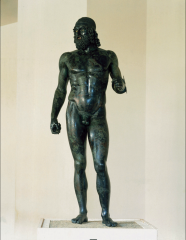
|
Name: Riace Warrior
Medium: Bronze with bone and glass eyes, silver teeth, copper lips Place: Found off Riace, Italy Date: 460-450 BCE Period: Classical Greek Sig: Was found in a shipwreck, which is why it survives; we usually know bronzes because of Roman copies of them, Arm is extended (this couldn’t have been done in stone), Looks very real like he’s about to speak to you |
|

|
Name: Discus Thrower
Artist: Myron Medium: Marble Place: ? Date: 450 BCE Period: Classical Greek Sig: Well proportioned body, you can see the movement, the athletic energy, very well proportioned body, lots of potential energy but no strain on the torso strangely |
|
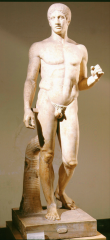
|
Name: Spear Bearer
Artist: Polykleitos Medium: Marble Place: Date: 450-440 BCE Period: Classical Greek Sig: Idealized proportions of the human body laid out in the "The Canon" which polykleitos wrote, this statue exemplifies that goal; cross balance between tensed and relaxed limbs to create a contrapposto |
|
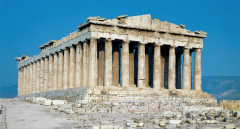
|
Name: Parthenon
Artist: Kallikrates and Iktinos Medium: Place: Acropolis, Athens Date: 447-438 BCE Period: Classical Greek |
|
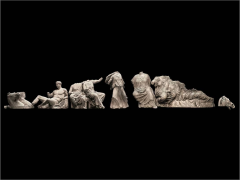
|
Name: East Pediment of the Parthenon
Artist: Phidias Medium: Marble Place: Acropolis, Athens Date: 438-432 BCE Period: Classical Greek Sig: Central figures are zeus and newborn athena, next to them are groups of gods and goddesses, Iris (messenger god) spreads news of Athena's birth, |
|
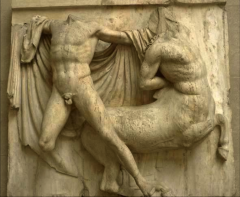
|
Name: Lapith Fighting a Centaur
Artist: Phidias Medium: Marble Place: Acropolis, Athens Date: 440 BCE Period: Classical Greek Sig: Metaphor for the battle between the Greeks and the Persians (the battle is close, which makes the Persians seem like a worthy opponent), The sculpture projected very far from the backdrop of the relief, drapery around three female goddesses expertly both covers and reveals their bodies |
|
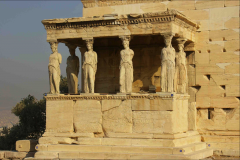
|
Name: Porch of the Maidens
Artist: Mnesicles Medium: Marble Place: Erechtheion Date: 421-405 BCE Period: Classical Greek Sig: Six stately caryatids support ionic entablature, each figure's weight is supported only on one engaged leg (like contrapposto) which creates a sense of rhythm |
|
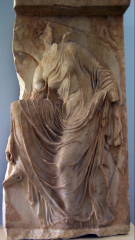
|
Name: Nike Adjusting Her Sandal
Medium: Marble Relief Place: Temple of Athena Nike Date: 425-400 BCE Period: Classical Greek Sig: Beautiful quality in the drapery giving it an almost membranous quality, outstretched wings give balance to her precarious position |
|
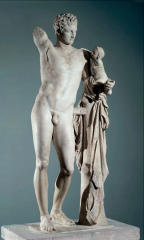
|
Name: Hermes and the Infant Dionysus
Artist: Praxiteles or his followers Medium: Marble with remnants of red paint Place: Date: 4th century BCE Period: Late Classical Greek Sig: Smaller head and more sensual figures than Polykleitos, slightly different proportions as well overall (8 heads tall versus 6.5-7 heads tall), uses an off-balance s-curve that needs a post to balance on (not like contrapposto), humanizes the subject with a touch of narrative |
|
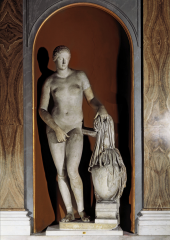
|
Name: Aphrodite of Knidos
Artist: Praxiteles Medium: Marble Place: Date: 350 BCE Period: Late Classical Greek Sig: Same kind of S-curve as Hermes and the Infant Dionysus with the smaller head proportion, She is being portrayed nude (she is given an excuse because she is trying to take a bath; male statues didn’t need this), She reacts with shame and tries to cover herself as the viewer walks in on her (this implies that the viewer is intended to be male) |
|
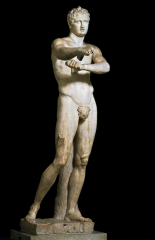
|
Name: The Scraper
Artist: Lysippos Medium: Marble Place: Date: 330 BCE Period: Late Classical Greek Sig: Athlete scraping away his sweat (same proportions as in Praxiteles); this is really a figure caught in motion, in the same way that Aphrodite of Knidos is caught in motion, Was originally done in bronze (as indicated by the dynamic pose and the use of the tree trunk for support in the marble copy) |
|

|
Name: Alexander the Greater Confronts Darius III at the Battle of Issos
Medium: Mosaic floor decoration Place: Pompeii, Italy Date: 1st century CE Roman copy of 310 BCE Greek painting Period: Late Classical Greek Sig: Definitive battle of the Persian campaign in which Alexander confronts the Persian leader while significantly outnumbered; he wins nonetheless and that begins the decline of Persian power. Look at the detail on the horse, even that expresses emotion. Focus of the leaders looking at each other over the tumultuous battle. |
|

|
Name: The Dying Gaul
Medium: Marble after original bronze Place: Pergamon, Turkey Date: 220 BCE Period: Hellenistic Sig : Shows the immortal warrior being defeated- pathos and emotionl; Sculpture is encouraging the viewer to walk around the figure- is very much three dimensional sculpture in the round; We can tell he is Gaul from his necklace and from his hairstyle, both of which are representative of the Celtic peoples. Despite being a non-Greek, he is shown nude, the implication here being that the Gauls fought valiantly and therefore becoming almost Greek-like in his death |
|
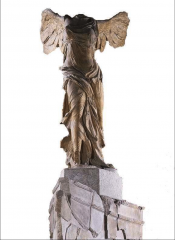
|
Name: Nike of Samothrace
Medium: Marble Place: Sanctuary of the Great Gods, Samothrace Date: 220 BCE Period: Hellenistic Sig: Put on the helm of a ship, uses wet drapery style, looks like she just landed with blowing clothes, You can really feel the wind blowing back on her, see the athleticism in the way her wings are extended and her muscles flexed, As much a piece of theatre as a work of sculpture |
|
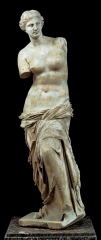
|
Name: Venus de Milo
Medium: Marble Place: Date: 150-125 BCE Period: Hellenistic Sig: Clearly a work that draws on Praxiteles’ Aphrodite of Knidos but uses an even more drastic s-curve combined with the contrapposto |
|
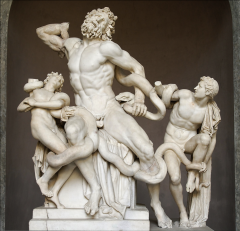
|
Name: Laocoon and his Sons
Artists: Hagesandros, Polydoros, and Athanadoros of Rhodes Medium: Marble Place: Date: 2nd-1st Century BCE Period: Hellenistic Sig: Shows the wrath of Poseidon being brought down on Laocoon and his Sons; Michelangelo was particularly impressed with its dramaticness and its depiction of the male figure; there was a contest over how the upper art is (michelangelo won over Rafael woops) |
|
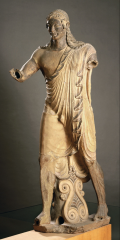
|
Name: Apulu
Medium: Painted terracotta Place: Veii Date: 500 BCE Period: Etruscan Art Sig: Archaic Greek smile, similar hairstyle; But has angular eyes, is not nude, very decorate drapery and decorative support structure, Caught in movement- very unlike Kouri from Greece |
|
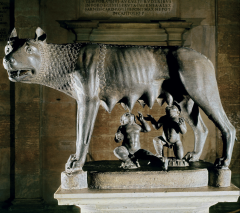
|
Name: She-Wolf
Medium: Bronze with glass-paste eyes Place: Capitoline Hill Date: 500 BCE Period: Etruscan Art Sig: Very alert, lifelike expression just like Apulu; looks ferocious and alive (this impression is helped along by glass-paste eyes) (Appears to have been caught in motion, teeth showing), Body is very thin, the ribs poke out, which contrasts with the size of her teats |
|
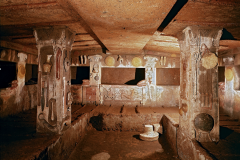
|
Name: Burial Chamber
Medium: Place: Tomb of the Reliefs, Cerveteri Date: 3rd century BCE Period: Etruscan Art Sig: Seem to use the Egyptian approach where tombs are homes for the dead, Sometimes these reached huge proportions (130 ft), arranged in cemeteries in an orderly manner along streets, much like the cities of the dead in Ancient Egypt, Objects for the dead both carved into the wall but also included in the whole |
|
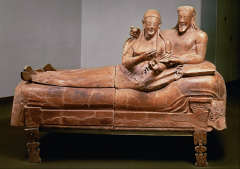
|
Name: Sarcophogus
Medium: Terracotta Place: Cervetari Date: 520 BCE Period: Etruscan Art Sig: Although the Etruscans preferred cremation, they had elaborate sarcophagi to house their ashes, Had to be fired in four sections because it is so large; Shows a couple reclining, again caught in motion, as if they are at a dinner party or something. This is different, as respectable women in Greek stayed home during banquets; only prostitutes attended (Etruscan women had more rights than their Greek counterparts; retained their names after marriage, attended these banquets, and were allowed to own property) |
|
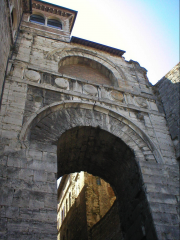
|
Name: Porta Augusta
Medium: Place: Perugia, Italy Date: 2nd Century BCE Period: Sig: There is a lot of debate over whether this work is Etruscan or Roman; it toes the line between the time periods of the two civilizations, Etruscans surrounded their cities with walls and defensive gates; this may be one of those gates, Has a long gateway with a rounded arch that recedes into the wall to create a barrel vault (extended arch), Also has an entablature element above the actual arch |
|
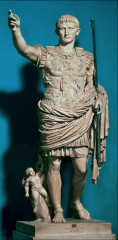
|
Name: Augusta of Primaporta
Medium: Marble, lightly colored Place: Primaporta Date: Early 1st Century CE Period: Roman Sig: Based heavily on the Spear Bearer of Greek art; almost the same contraposto and the same bent art (this time holding up a robe), Also not nude; This kind or oratorical gesture would have been familiar to the Romans of the time; this gesture makes the Spear Bearer pose much more active, as the motion of the body extends all the way up the figure to the arms, Cupid is giving Augustus his blessing and the fact that he is barefoot accentuates this fact, Also shows that the family of Caesar draws their lineage from the goddess Venus, Depicted very youthfully as opposed to the older portraiture of the old Republic; this is a big shift from years past at the time (Augustus continued to have himself portrayed like this even as an old man) |
|

|
Name: Atrium, House of the Silver Wedding
Medium: Place: Pompeii Date: Early 1st Century CE Period: Roman Sig: |
|
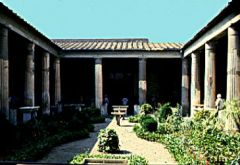
|
Name: Peristyle Garden, House of the Vettii
Medium: Place: Pompeii Date: 2nd Century BCE, rebuilt 60-79 CE Period: Roman Sig: |
|
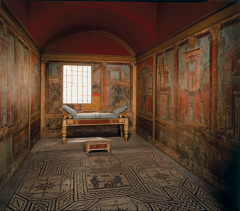
|
Name: Reconstructed bedroom from the House of Publius Fannius Syntistor, Boscoreale
Medium: Place: Pompeii Date: Late 1st Century CE Period: Roman Sig: Fantastic urban panorama, surfaces dissolve to open up a maze of architecture, which is shown with intuitive perspective |
|
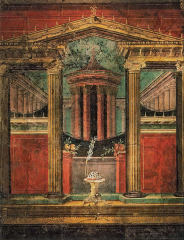
|
Name: Cityscape
Medium: Wall painting Place: House of Publius Fannius Synistor, Boscoreale Date: Late 1st century CE Period: Roman Sig: Creates artificial space inside the bedroom; recedes dramatically; this space is created by diagonals along the side of the cityscape |
|
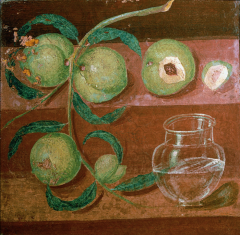
|
Name: Still Life
Medium: Wall Painting Place: Herculaneum Date: 62-79 CE Period: Roman Sig: Unripened peaches and a glass of water; uses illusion to great effect to create a recession into space |
|
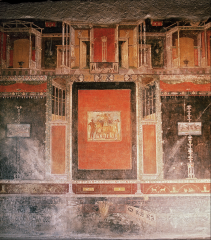
|
Name: Detail of a wall painting in the House of M. Lucretius Fronto
Medium: Wall painting Place: Pompeii Date: Mid 1st century CE Period: Roman Sig: Wall paintings become more elaborate over time; Painting that is painted to look like it is hung on the wall (which is also painted onto the actual wall) |
|
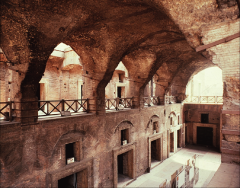
|
Name: Main Hall of the Markets of Trajan
Artist: Apollodorus of Damascus Medium: Concrete and brick Place: Rome Date: 100-112 CE Period: Roman Sig: 150 shops and offices inside; semicircular brick building with five tiers of shops set into the Quirinal Hill |
|
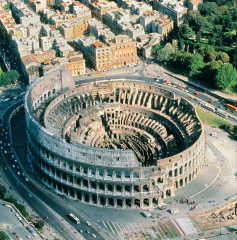
|
Name: Colosseum
Medium: Concrete and marble Place: Rome Date: 72-80 CE Period: Roman Sig: Build by the flavian emperors (Vepascian and Titus) and is named after a Colossus of Nero right outside the Colosseum, One of the first projects under Vespascian; it was built on the site of an artificial lake near Nero’s palace. This made it a shrewd political move on the part of Vespascian |
|
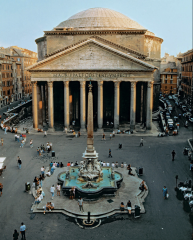
|
Name: Pantheon
Medium: Place: Rome Date: 118-128 CE Period: Roman Sig: Temple to Mars, Venus, and the divine Juliues Caesar; giant rotunda at the very center with a oculus at the top is a marvel of ancient architecture (this lets in a mini sun and weather); sunken panels (coffers) in the ceiling draw our eyes; the wall has niches (exedrae) with statues of different gods |
|
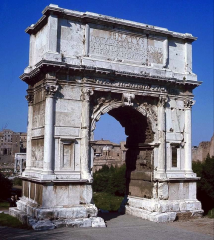
|
Name: Arch of Titus
Medium: Concrete and white marble Place: Rome Date: 81 CE Period: Roman Sig: Was a base for a lost bronze statue of the emperor, columns are on the faces of the arch in the composite order supporting an entablature, inscription declares that this was erected by the senate and people to honor Titus |
|
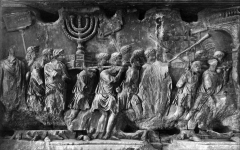
|
Name: Spoils from the Temple of Solomon, Jerusalem
Medium: Marble relief Place: Arch of Titus, Rome Date: 81 CE Period: Roman Sig: Testament to the sacking of Jerusalem by the Romans to stop a jewish revolt, menorah dominates the scene, varying depths in the relief are used to distinguish figures, the soldiers seem boisterous and alive |
|
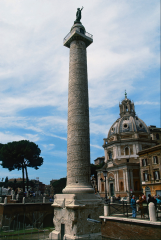
|
Name: Column of Trajan
Medium: marble Place: Rome Date: 113-116 CE Period: Roman Sig: Trajan portrayed as a strong leader and barbarians are depicted as worthy opponents through the scenes that spiral up the length of the column; statue of trajan himself at the very top of the column |
|
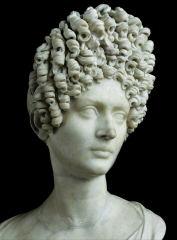
|
Name: Young Flavian Woman
Medium: Marble Place: Date: 90 CE Period: Roman Sig: Shows the latest fashion in the Roman courts, executing the hair required skillful chiseling and drillwork to create a very lifelike effect |
|
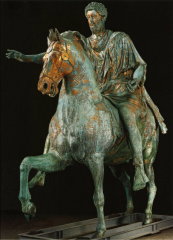
|
Name: Equestrian Statue of Marcus Aurelius
Medium: Bronze Place: Date: 176 CE Period: Roman Sig: |
|
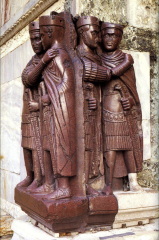
|
Name: The Tetrarchs
Medium: Place: Porphyry Date: 300 CE Period: Roman Sig: |
|
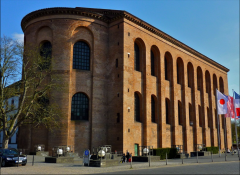
|
Name: Basilica at Trier
Medium: Place: Germany Date: Early 4th century Period: Roman Sig: |
|
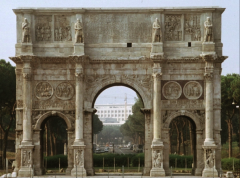
|
Name: Arch of Constantine
Medium: Place: Rome Date: 312-315 CE Period: Roman Sig: |
|

|
Name: Distribution of Largess
Medium: Marble frieze Place: Arch of Constantine, Rome Date: 312-315 CE Period: Roman Sig: |
|
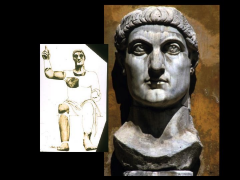
|
Name: Constantine the Great
Medium: Marble Place: Basilica of Maxentius and Constantine, Rome Date: 325-326 CE Period: Roman Sig: |

